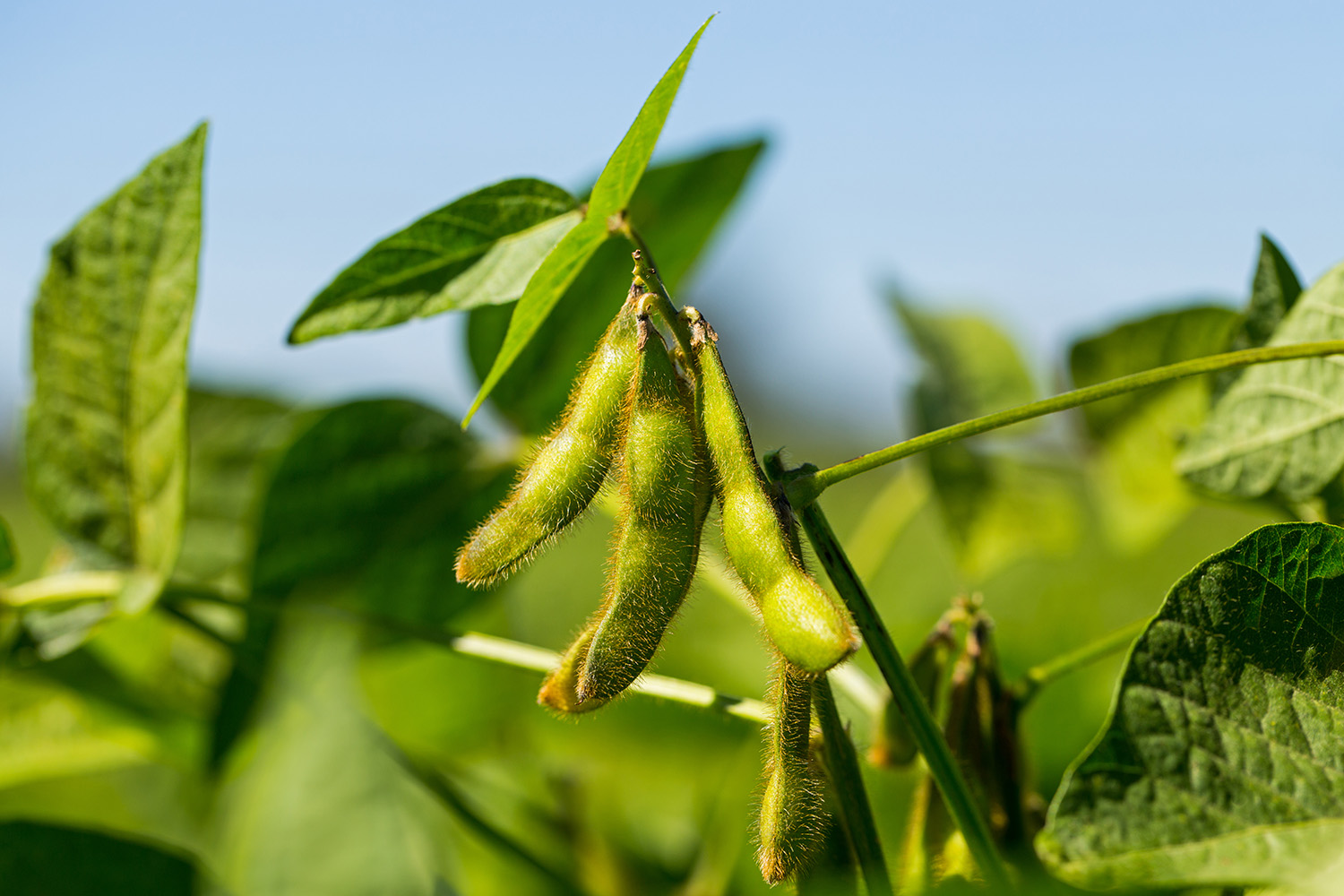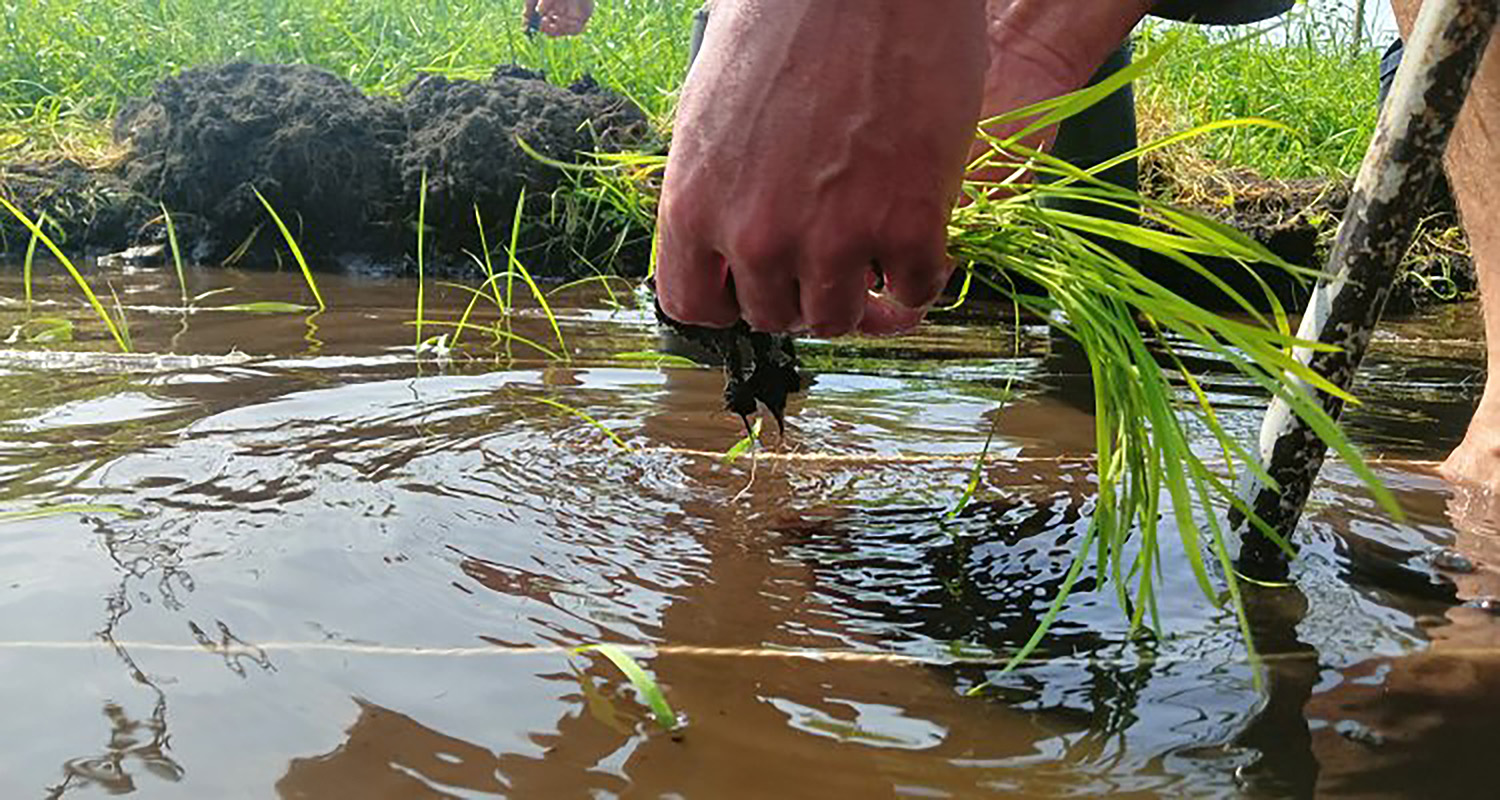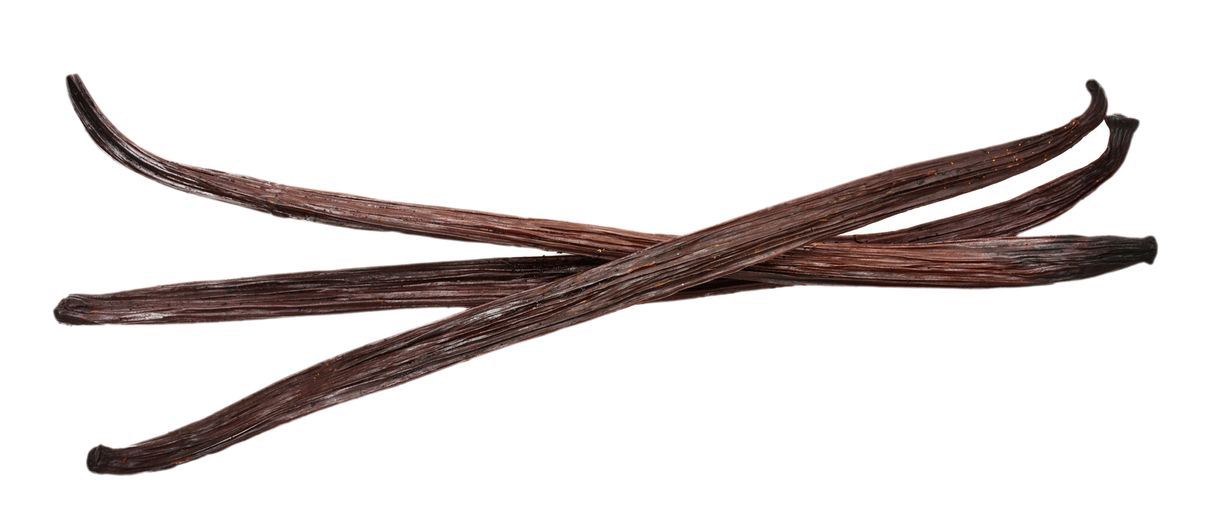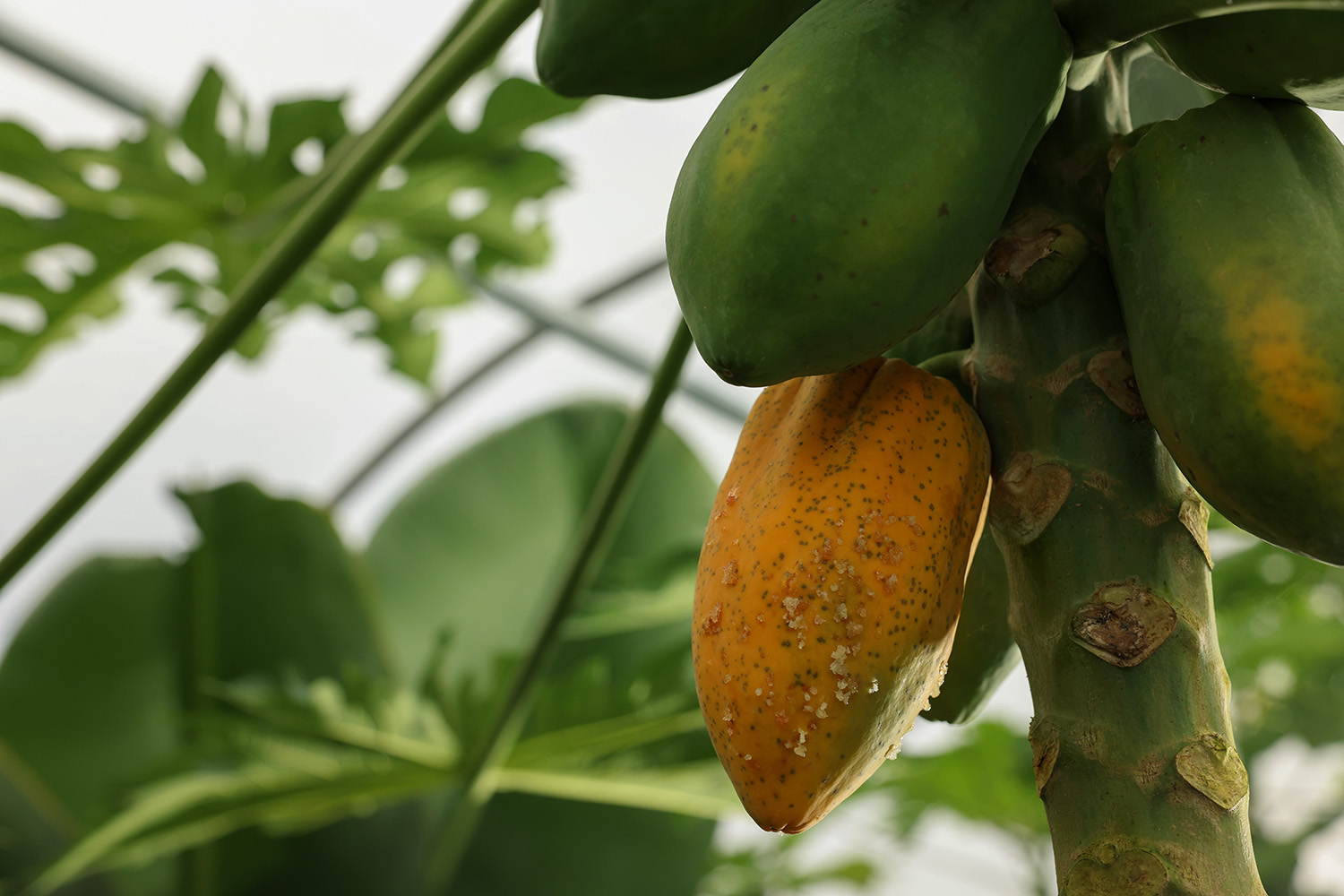Wageningen, The Netherlands
June 21, 2024
Drier summers, wetter winters, higher temperatures and more frequent heavy downpours. Climate change is now a fact of life that is affecting global crop production. Will we soon be trading kale stew and pea soup for homegrown soybeans and risotto rice? Wageningen University & Research is working with growers to explore the potential for growing tropical and subtropical crops in the Netherlands
Dutch soybeans
One crop increasingly being cultivated in the Netherlands is the soybean. There are several reasons for this, says Ruud Timmer, research associate in pulses. “Due to the protein transition, we are eating more plant-based products. Soybeans, in the form of soy milk, soy burgers or edamame, for example, are becoming more popular. Demand for local products is also growing. We’re becoming much more aware of how food production impacts the places of origin. In South America, for example, soybean cultivation is destroying the rainforests. Transport from distant countries also increases our climate footprint."
 Soybeans (Edamame)
Soybeans (Edamame)
Despite more widespread soy cultivation in the Netherlands, our climate is not ideally suited for soybeans - or at least not yet, Timmer stresses. "Soy thrives in areas with high temperatures and sufficient rainfall. However, temperatures aren’t yet high enough in the Netherlands. As it is vulnerable to frost, you can’t start sowing soy until May. For ripe beans, you need to wait until October before harvesting. Higher average spring temperatures would allow us to start sowing earlier in the Netherlands, giving the bean a longer ripening period. At the same time, we are also studying cultivars that thrive in cool climates, such as in north-western Europe."
But even if climate conditions or genetic characteristics were optimal, it is questionable whether soybean cultivation would be profitable here. Timmer: "Soy has low (financial) yields compared to other crops like potatoes, beets and onions. We can still increase the yield per hectare, but soybean cultivation won’t play a major role in our country. I see more opportunities for importing soy from neighbouring countries, which have much more land available and where soy fits better in the crop rotation. Large-scale cultivation is already taking place in central France and northern Italy, as well as in some countries along the Danube, such as Serbia, Romania and Ukraine. Which is still closer to home than North or South America."
Long beans from community gardens
Particularly for home consumption and community gardens of people from different cultural backgrounds, the potential for semi-tropical crops is growing in our country, says research associate Martina Huber. Water spinach, long beans and herbs like lemon basil and Thai coriander are growing well when cultivated under plastic in poly tunnels and profiting from the increasingly warmer Dutch summers. These vegetables are showing potential for the future also, because some products have a very limited shelf life. Growing them close to home reduces the impact of air freight on greenhouse gas emissions. Successful experiments are already taking place in our country.The public is still unfamiliar with many exotic crops, such as bitter gourd, snake gourd and waxed gourd, which are cucurbit crops, related to pumpkin and squash, that can do well in greenhouses without heating.
Polder rice
Another product vulnerable to climate change is Japonica rice, used for e.g. risotto. One of the areas that has suffered greatly from droughts in recent years is Italy's Po Valley, which provides much of our risotto rice, says associate professor Tom Schut from the Plant Production Systems Chair Group. “If droughts become a more common occurrence, risotto rice cultivation in Europe will need to move further north to places where water shortage is less of a problem. Several years ago, the rice cultivar Lotto was successfully introduced in northern Switzerland. The region has a fairly similar climate to the Netherlands, so in 2023 we teamed up with Leiden University to experiment with risotto rice at the Polderlab Vrouwe Venne near Leiden."
 Rice experiment in the Netherlands
Rice experiment in the Netherlands
The Polderlab is based in a peatland area. According to Schut, peatland is ideal for growing risotto rice. "Rice grows well on wet soil and peatland naturally has a high-water table. In the Netherlands, however, we maintain an artificially low water level for agriculture and habitation. This increasingly creates problems such as land subsidence, seawater intrusion and salinization with complex water management to respond to rising sea levels. Drained peatlands also result in very high greenhouse gas emissions. By raising the water level, we not only create good conditions for rice cultivation, but also strongly reduce greenhouse gas emissions and combat the impact of climate change. However, this requires major interventions in the water system and impacts land use."
Due to the relatively cold late summer, the experiment in Leiden yielded very little rice in 2023. Nevertheless, Schut still sees potential for rice cultivation in the Netherlands. "We will be continuing our research. For example, we will look for the cultivar best suited to Dutch conditions and explore how best to manage cultivation to minimise greenhouse gas emissions. There are economic opportunities too. In future, rice cultivation on wet peatland may become more lucrative than livestock farming. Eventually, this might persuade farmers to switch. However, 'polder rice' is likely to be a niche product. In terms of cost and land area, we can’t compete with other countries."
Tropical and subtropical crops
Exotic crops are not only grown outdoors, but also in greenhouses. The ability to regulate factors such as temperature, light and water in an enclosed space like a greenhouse means it is even possible to grow tropical crops in the Netherlands, says Filip van Noort, research associate in greenhouse cultivation. “Like avocados, papaya, passion fruit, vanilla and black pepper. These wouldn’t survive in our outdoor climate but are fine indoors. In their countries of origin, these crops are under pressure. Not only due to climate change, but also due to increasing water scarcity, water pollution and the use of plant protection products."
 Vanilla
Vanilla
Van Noort shows the opportunities and constraints for growing tropical and subtropical crops in the Netherlands. "Black pepper is interesting, but when you dry it, you have very little left. That means it’s only profitable as a fresh product, and the market for that is still underdeveloped in the Netherlands. In the case of vanilla, it takes at least three years to get anything. You often don't get that much time in the market. Papaya has been grown on a few hectares, but this experiment was unfortunately forced to stop. However, Dutch-grown passion fruit is in demand in restaurants, for example. Studies are currently ongoing to see whether this could become a lucrative venture. And we need to study whether year-round cultivation is feasible and how much energy this will require for the different crops. The higher our energy consumption, the bigger our climate footprint, but water use efficiency and safe food should also be taken into account."
 Papayas in a greenhouse
Papayas in a greenhouse
Besides providing a tasty harvest, growing tropical crops in Dutch greenhouses can provide valuable knowledge for countries where cultivation is under pressure. Van Noort: “We’ve experimented with recirculating water and nutrients when growing avocados, for example. This allows you to use much less water for the same yield. It would be interesting to see whether this knowledge could also be used in countries like Chile and Spain to reduce water consumption in avocado cultivation there. We are also exploring whether crops that are currently cultivated outdoors can be moved to more covered conditions in the country of origin, such as saffron in Iran or ginger and turmeric in India. Using technology, you could grow these crops in these countries in a healthier and more sustainable way."
Are you already familiar with taro?

Research associate Eric Schranz is enthusiastic about taro as a future crop. Taro is a starchy tuber, like potatoes or sweet potatoes. The traditional potato is finding the changing climate increasingly challenging, so taro could be a good alternative.Many people associate taro with tropical or subtropical climates, but it is also grown in cooler regions, such as the mountains of Japan or Ethiopia. Some taro varieties are drought-resistant, while others thrive in wet conditions. This offers opportunities for research and cultivation even in cooler climates like the Netherlands, says Schranz.
Op zoek naar de Hollandse pot van morgen: van Nedersoja tot polderrijst
Drogere zomers, nattere winters, hogere temperaturen en vaker enorme plensbuien. Klimaatverandering is een feit en dat heeft wereldwijd gevolgen voor de productie van gewassen. Ook in Nederland verbouwen we steeds meer exotische gewassen. Ruilen we boerenkoolstamppot en erwtensoep straks in voor sojabonen en risottorijst van eigen land? Wageningen University & Research onderzoekt samen met telers de kansen en beperkingen voor nieuwe teelten in Nederland.
Nedersoja
Een gewas dat zich steeds vaker laat zien in de Nederlandse bodem is de sojaboon. Volgens Ruud Timmer, onderzoeker op het gebied van peulvruchten, heeft deze toename meerdere oorzaken. “Door de eiwittransitie eten we steeds meer plantaardige producten. Sojabonen, in de vorm van bijvoorbeeld sojamelk, sojaburgers of edamame, worden steeds populairder. Daarnaast groeit de vraag naar lokale producten. We zijn ons meer en meer bewust van de impact van voedselproductie op de plekken van herkomst. De teelt van soja zorgt in Zuid-Amerika bijvoorbeeld voor het verdwijnen van regenwouden. Ook draagt transport uit verre landen bij aan een hoge klimaatvoetafdruk.”
Ondanks dat op steeds meer plekken in Nederland soja wordt geteeld, is ons klimaat (nog) niet bij uitstek geschikt voor sojabonen, benadrukt Timmer. “Soja doet het goed bij een hoge temperatuur en voldoende neerslag. Met name de temperatuur is in Nederland nu jaarrond niet hoog genoeg. Omdat soja vorstgevoelig is, kun je pas in mei gaan zaaien. Wil je een rijpe boon, dan kun je niet eerder dan in oktober oogsten. Door gemiddeld hogere temperaturen in het voorjaar zouden we in Nederland eerder kunnen beginnen met zaaien, waardoor de boon een langere rijptijd heeft. Tegelijkertijd doen we onderzoek naar rassen die goed gedijen in koele klimaten, zoals in Noordwest-Europa.”
Maar al zouden de klimatologische omstandigheden of raseigenschappen optimaal zijn, dan nog is het de vraag of sojateelt hier rendabel is. Timmer: “Soja heeft vergeleken met andere gewassen, zoals aardappelen, bieten en uien, een lage fysieke en financiële opbrengst. De opbrengst per hectare kunnen we nog wel verhogen, maar een grote speler zal de sojateelt in ons land niet worden. Meer kansen zie ik voor de import van soja uit landen om ons heen, waar veel meer grond beschikbaar is en soja beter past in het bouwplan. In Midden-Frankrijk, Noord-Italië, maar ook in enkele Donau-landen, zoals Servië, Roemenië en Oekraïne, vindt nu al grootschalige teelt plaats. Dat is nog altijd dichter bij huis dan Noord- of Zuid-Amerika.”
Kousenband uit volkstuintjes
Vooral voor zelfconsumptie en gemeenschapstuinen van mensen met verschillende culturele achtergronden, groeit het potentieel voor semi-tropische gewassen in ons land, ziet onderzoeker Martina Huber. Waterspinazie, kousenband en kruiden als citroenbasilicum en Thaise koriander zijn in haar ogen veelbelovend. Ook omdat sommige producten maar heel beperkt houdbaar zijn. Door ze dicht bij huis te telen, vermindert de CO2-impact van luchtvracht. Er vinden in ons land al succesvolle experimenten plaats. Op dit moment zijn veel exotische gewassen bij het grote publiek nog onbekend, zoals bitter gourd, snake gourd of waxed gourd. Dit zijn pompoengewassen die het goed zouden doen in koude kassen.
Polderrijst
Een ander product dat kwetsbaar is voor klimaatverandering is rijst. Een van de gebieden die in de afgelopen jaren sterk te lijden heeft gehad onder verdroging is de Italiaanse Po-vallei, waar we een flink deel van onze risottorijst vandaan halen, zegt onderzoeker Tom Schut van de leerstoelgroep Plantaardige Productiesystemen. “Als dat vaker gebeurt, zal de risottoteelt in Europa steeds verder op moeten schuiven naar het noorden, naar plekken met minder waterproblemen. In Zwitserland, ten noorden van de Alpen, wordt al een paar jaar succesvol het risotto-ras Lotto verbouwd. Omdat dat gebied klimatologisch niet veel verschilt van Nederland, zijn we samen met Universiteit Leiden hier in 2023 mee gaan experimenteren in het Polderlab Vrouwe Venne nabij Leiden.
Het Polderlab ligt in een gebied met veengrond. Deze gebieden zijn volgens Schut zeer geschikt voor de teelt van risottorijst. “Rijst groeit goed op natte grond. Veengrond heeft van nature een hoge waterstand. Alleen houden we in Nederland het peil kunstmatig laag voor landbouw en bewoning. Dit zorgt steeds vaker voor problemen, zoals bodemdaling, verzilting, complex waterbeheer bij een stijgende zeespiegel en een grote uitstoot van broeikasgassen. Door het peil te verhogen, maken we land niet alleen geschikt voor rijstteelt, maar beperken we ook broeikasgasemissies en bestrijden we gevolgen van klimaatverandering. Dit vraagt alleen wel om grote ingrepen in het watersysteem en het landgebruik.”
Vanwege de relatief koude nazomer was de opbrengst van het rijstexperiment in Leiden minimaal. Toch verwacht Schut dat risottoteelt in Nederland kansrijk is. “We gaan dan ook verder met ons onderzoek. We gaan onder meer op zoek naar het beste ras voor de Nederlandse omstandigheden en hoe we de teelt het beste kunnen inrichten om onder andere broeikasgasemissies te minimaliseren. Economisch zijn er ook kansen. Op natte veengrond is rijstteelt in de toekomst mogelijk lucratiever dan veeteelt. Dat kan het voor boeren op termijn aantrekkelijk maken om over te stappen. Maar ‘polderrijst’ zal wel een nicheproduct worden. Qua kostprijs en landoppervlak kunnen we niet concurreren met andere landen.”
(Sub)tropische gewassen
Niet alleen in de buitenlucht, ook in kassen vindt teelt van exotische gewassen plaats. Omdat je in zo’n gesloten ruimte factoren als temperatuur, licht en water kunt reguleren, worden in Nederland zelfs tropische gewassen verbouwd, vertelt Filip van Noort, onderzoeker op het gebied van kasteelt. “Denk aan avocado’s, papaja, passievruchten, vanille en zwarte peper. Deze zouden in ons buitenklimaat niet overleven, maar binnen wel. Op plekken waar deze gewassen van oorsprong geteeld worden, staan ze onder druk. Niet alleen door klimaatverandering, maar ook door toenemende waterschaarste, watervervuiling en gebruik van gewasbeschermingsmiddelen.”
Van Noort laat zien wat de kansen en beperkingen zijn voor de teelt van (sub)tropische gewassen in Nederland. “Zwarte peper is interessant, maar als je het gaat drogen, houd je geen kilo’s over. Het is dus alleen vers rendabel, alleen is de markt hiervoor in Nederland nog niet ontwikkeld. Voor vanille geldt dat het minimaal drie jaar duurt voordat je iets hebt. Zoveel tijd krijg je vaak niet in de markt. Papaja wordt nu gekweekt op een paar hectare, maar dat eten we nauwelijks in Nederland. Naar passievruchten van Nederlandse bodem is wel vraag, bijvoorbeeld van restaurants. Momenteel wordt onderzocht of dit lucratief kan worden. Ook moet nog worden gekeken of jaarrond telen mogelijk is. Hierbij moet onder meer worden vastgesteld hoeveel energie dit gaat kosten. Hoe hoger het energieverbruik, hoe hoger de klimaatvoetafdruk.”
De teelt van tropische gewassen in Nederlandse kassen kan naast een smaakvolle oogst ook waardevolle kennis opleveren voor landen waar de teelt onder druk staat. Van Noort: “We hebben bijvoorbeeld geëxperimenteerd met het recirculeren van water en voedingsstoffen bij de teelt van avocado’s. Hierdoor kun je voor dezelfde opbrengst veel minder water gebruiken. Het zou mooi zijn te onderzoeken of deze kennis ook gebruikt kan worden in landen als Chili en Spanje om het waterverbruik bij de avocadoteelt daar te verminderen. Daarnaast kijken we of teelten die nu nog in de buitenlucht plaatsvinden verplaatst kunnen worden naar meer bedekte omstandigheden in het land van herkomst, zoals saffraan in Iran of gember en kurkuma in India. Met behulp van technologie zou je deze gewassen in deze landen op een gezondere en duurzamere manier kunnen telen.”
Ken je taro al?
Onderzoeker EricSchranzis enthousiast over taro als toekomstig gewas. Taro is een zetmeelrijke knol, vergelijkbaar met aardappel of zoete aardappel. Omdat de traditionele aardappel het in het veranderende klimaat steeds moeilijker krijgt, kan taro een goed alternatief zijn.Veel mensen associëren taro met een tropisch of subtropisch klimaat, maar het wordt ook geteeld in koelere gebieden, zoals in de bergen van Japan of Ethiopië. Er zijn taro-rassen die goed bestand zijn tegen droogte, terwijl andere rassen juist goed gedijen in natte omstandigheden. Dit biedt mogelijkheden voor onderzoek en teelt, zelfs in koelere klimaten zoals in Nederland, aldus Schranz.